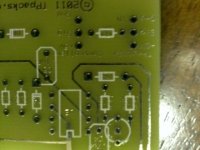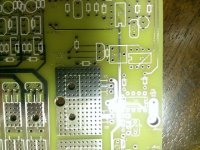fechter said:
512-KA431AZTA is good, just a bit more expensive than the other ones. It has a tighter tolerance.
I don't know about the JST connectors. Some places sell connectors with wires already attached.
Using separate sensing wires for the Zephyr might be a good idea. Otherwise the voltage drop in the original sensing wires will throw the voltage readings off a bit.
Do you have a way to interface the LVC to your inverter? The Zephyr does not have an active cutoff that carries the full discharge load. You need a way to shut down the load when the LVC hits. The inverter should have some kind of interface that does this already.
I ended up getting
FAN431AZXA , got a bit impatient board is on its way allready, and the name resembled more, and yes come to think of it it's probably best to run separate sensing wires, paralel them at the cell terminals, if I am not mistaking the original ones are bolted to the tabs, besides I am looking at 1 amp bleed current on this version right? I need some heavier gauge anyway.
as for the LVC interface it has crossed my mind but there is so much else I am trying to take in I figured I'll save that for later, the inverter does have some interface I have not yet looked into it but the original BMS shutts it down when first cell reaches lvc which it is set at 2.5v, there is a phone cable and a 2 wire ( jst looking like ) between the original bms and the converter, my money is on the 2 wire, the system is rather geeky in that aspect, but they never got the basics right,
I believe I read about the zephyr having some circuit for a buzzer, I even seen it on a video, one thought I had was to wire some NC relay instead of that buzzer, and the relay's contacts in series with the existing cutoff wire between the original bms and converter, once the system trips it does not automaticaly come back on unless manually reset, which I am fine with, guess I'll cross that bridge when I get there, first I have to have a proper way of charging/balancing that battery, or everything else is dead weight and as far as that goes I honestly do not know of any device capable other than this zephyr, like it has been noted most comercial BMS have 120mA balancing curent on a good day (70mA the one I came across last), what is that going to do on 80ah blocks charged at 15 amp? besides some of these have some weird strategies that don't work, mine has a balancing circuit like that, but the idea was to balance on the bottom at the end of the charge or something like that, turns out it was a disaster and the solution was to disable it, than the bateries got so bad out of wack I don't think the charger ever made it to the CV threshold, cell 16 would trip HVC first I thought it was a dumb charger before I opened it up :lol:
so what ever I have to do to interface it, i'll cross that bridge when I get there, I would have the 2.5v LVC from the original just in case, but what I am really hoping for, if these cells are consistently charged to the same level, every time and they start behaving similarily every time, wich would be a first, the converter will cut off at 47v, long before any of the LVC's trip, I got a constant discharge ( no throttle so no severe sag, in theory I think ), it would be nice to have a charge terminate when the current is too low, and a discharge terminate when pack voltage reaches minimum, that never happened in any of these systems, first one to blow you're done that was their strategy, I got to build a zepher regardless of any interfacing I may have to deal with.
So my board is on its way, components are ordered and all were in stock, digikey had some of those tc54 2.7v and the caps that were discontinued, so for the most part I got the original parts ( I hope ), I got a slightly different Hamond box, the black one was on backorder, and this one description said it's clear ( collor ) I'm curious to see what arrives in the mail.
for what it's worth, to anybody considering this build, my order was just shy of $100, but I did get some doubles ( something to do with custom fit), no wires or nuts and bolts, I have those and they are available locally too, considering the only known comercially available BMS that is supposed to be a direct replacement retails for $555 plus tax shipping .... and there is not much of a description available as to how it works ( probably some weird unreliable ), I believe it has about a tenth 1/10 the balancing capability of a Zephyr, in other words it will never balance that pack ( just make you feel better about blowing cells at least you tried), or I would need 10 of them in paralel to get an initial balance. need I say more, I am not too good or experienced with electronics, that is pretty much obvious, I can build just about anything thou, well see how it goes but as far as I know there just isn't anything comercially available that specs even come close, this is the only way to go.
I was really bumed up this spring to find out they were not available anymore ( read about them years ago ), special thanks to zenid for taking one for the team and keeping those things stocked, I looked for other options all summer, and I was seriously considering building one from scratch if I have to or try to find something close and mod it to work similarly,
as for the Brains behind it, I'm speechless to achieve so much with so little and so simplistic, this last one I like most, I hope I got it in me to see this through, if anything I feel priviledged to have a go at it, speaking of which, whatever happened to Andy?





